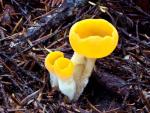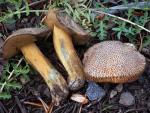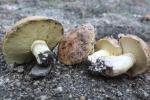|
|
.jpg)
|
Sarcodon imbricatus
|
Pileus
Cap 5-25 cm broad, convex, depressed to infundibulate at the center, margin at first inrolled, becoming decurved, sometimes wavy or lobed; surface dry, consisting of coarse, dark-brown to almost black, erect scales on a pallid to light brown background, in age the scales sometimes partially weathering away; flesh thick, soft, cream to buff, unchanging; odor: mild; taste: mild to bitter. |
.jpg)
|
Sarcoscypha coccinea
|
Sporocarp
Fruiting body 1-5 cm broad, 0.5-2 cm high, cupulate with a slightly inturned margin, cup interior (fertile surface) brilliant scarlet, margin whitish, cup exterior white, tomentose; stipe absent to 3 cm tall, 4-6 mm thick, tapering downwards. |
.jpg)
|
Sarcosoma mexicanum
|
Sporocarp
Fruiting body 3.0-6.0 (9.0) cm tall, 3.0-4.0 cm broad, top-shaped, stipitate, broadly cupulate at maturity; margin upturned to incurved, sometimes wavy; exterior wrinkled to furrowed, covered by a fine, dark-grey tomentum, blackening where handled; interior or hymenial surface black, more or less glabrous, slightly furrowed; context a blackish gel filling the tapered base and the cup wall, odor not distinctive; taste mild. |
.jpg)
|
Sarcosphaera coronaria
|
Sporocarp
Fruiting body 2.0-10.0 cm broad, at first hypogeous, then partially emergent, with or without a short base; ascocarp compressed-globose, hollow, opening by a pore, then appearing urn-shaped, at maturity the margin sometimes coarsely toothed; outer surface whitish, typically dingy from adhering soil, inner surface (hymenium) pale-lavender to pinkish-brown, glabrous; context colored like the hymenium but paler, up to 3.0 mm thick, brittle; odor and taste not determined. |
.jpg)
|
Schizophyllum commune
|
Sporocarp
Fruiting body a leathery, fan-shaped bracket, 1-3.5 cm broad, frequently lobed or fused at the base with other brackets; upper surface densely hairy, light greyish-brown when moist, ashy grey to white when dry; lower surface light grey consisting of well spaced, longitudinally split gills; stipe usually absent; flesh thin, light grey to brown, tough. |
.jpg)
|
Scleroderma cepa
|
Sporocarp
Fruiting body buried to epigeous, 1.5-5 cm broad, globose, at maturity often slightly flattened to cushion-shaped, the base pinched or folded, attached to the substrate via a tuft of mycelium, the latter sometimes aggregated into a pseudostipe; peridium when young, 1-1.5 mm thick, tough, smooth, becoming finely cracked or areolate, especially the upper portion; spores released via irregular splitting or "cratering" of the apex; color: white, soon tinged vinaceous to pinkish-brown or ochraceous-brown, bruising darker brown where handled or injured; gleba white turning purple-black, firm-textured, with interspersed white mycelium, in age, dull brown; odor: of mushrooms; taste: mild. |
.jpg)
|
Sclerotinia veratri
|
Sporocarp
Apothecium shallowly cupulate, 1.5-10.0 mm broad; margin incurved in youth, erect in age, lacking hairs; hymenium and external surface similar: glabrous, moist, ochre-brown to dull vinaceous-brown; stipe up to 2.5 cm long, 0.5-1.0 mm, spindly, equal to enlarged at the apex; surface glabrous to inconspicuously, patchy-tomentose, tan, ochre-brown to dark reddish-brown, arising from a blackish crust or rice-grain-shaped sclerotium; odor and taste not distinctive |
.jpg)
|
Scutellinia scutellata
|
Sporocarp
Fruit body 0.5-1.5 cm broad, at first nearly round, becoming disc-shaped, the margin reflexed, sometimes wavy, with long (1-2 mm), stiff, dark-brown to black hairs; hymenium (upper surface) red to orange, smooth; lower surface colored like the hymenium but duller, also hairy, but not so conspicuously as the cup margin; stipe absent; flesh thin. |
.jpg)
|
Simocybe centunculus
|
Pileus
Pileus 1.0-2.5 cm broad, convex, expanding to nearly plane; margin incurved, decurved at maturity; surface when young, minutely pruinose to velvety, olive-brown, the margin paler, translucent striate, hygrophanous, in age opaque, ochre-brown to dull-brown; context thin, olive-brown. |

|
Sowerbyella rhenana
|
Habitat
Prefers wet mossy areas under conifers; northwestern California. Uncommon. |
.jpg)
|
Sparassis crispa
|
Sporocarp
Fruiting body 20 cm broad, 40 cm tall, sometimes larger, a rounded mass of flattened, wavy, leaf-like branches, white to pale yellow; branch edges discoloring brown in age; arising from a large root-like sterile base, the upper portion appearing chambered when sectioned, solid below; flesh white. Hymenium on the flattened surfaces of the fruiting body. Odor fragrant, somewhat spicy. |
.jpg)
|
Stereum hirsutum
|
Sporocarp
Fruiting body annual or short-live perennial, resupinate when young, forming thin, leathery overlapping shelves at maturity, 1-3.5 cm wide and up to 8 cm long when fused with adjacent shelves; upper surface hairy, undulate, lobed, banded orange-brown to yellow-brown, older tissue grey to greyish-brown; lower fertile surface smooth, orange-buff to pale-buff, if zoned, less conspicuously than the upper surface; flesh 0.5-1.0 mm thick, pliant when young, tough in age; stalk absent. |
.jpg)
|
Stereum ochraceo-flavum
|
Sporocarp
Fruiting body annual, effused-reflexed, 2.0-2.5 cm long, 1.0-1.5 cm broad, thin, sessile, broadly conic to semicircular with a concave hymenial surface, often umbonate at the attachment point; margin wavy, sometimes fused to adjacent fruiting bodies; upper surface even to undulate with dense, mostly erect hairs, faintly-zoned, cream to buff-brown, the margin paler, senescent material greyish-white; hymenial surface glabrous with shallow bumps and depressions, pale-tan, at times dull-yellow or orange, inconspicuously-zoned; context cream-buff, about 1 mm thick, pliant when fresh, soon tough and leathery; in dry specimens the cap margin folded over the hymenium, reviving when moistened; odor and taste not distinctive. |
.jpg)
|
Strobilurus albipitatus
|
Pileus
Cap 1.5-3.0 cm broad, convex, expanding to plano-convex, the disc with or without a low umbo; margin decurved, plane to sometimes raised at maturity, striate; surface glabrous to slightly wrinkled; color variable: at first, brown to greyish-brown, the margin typically lighter, fading to cream-buff or pale-tan; context thin, pallid, unchanging; odor and taste mild. |
.jpg)
|
Strobilurus diminutivus
|
Pileus
Cap 1.5-4.0 mm broad, at first hemispheric to convex, broadly convex in age; margin incurved, then decurved, minutely fringed; surface when moist, faintly striate-rugulose to near the disc, pubescent with a hand lens; color pallid, pale-pink, tan, to tawny-brown, occasionally olive-brown, the disc darker; context membranous, colored like the disc; fruiting body reviving after drying; odor and taste not distinctive. |
.jpg)
|
Strobilurus trullisatus
|
Pileus
Cap 0.4-1.7 cm broad, convex, expanding to nearly plane and slightly depressed; surface smooth to faintly wrinkled, pallid brown at the disc shading to a pale pinkish, striate margin; flesh thin and white. |
.jpg)
|
Stropharia ambigua
|
Pileus
Cap 4.0-14 cm broad, nearly conic when young, becoming convex to plane, occasionally slightly umbonate; surface pale yellow to straw-colored to orange-yellow, viscid when moist; margin with adhering veil fragments (appendiculate), sometimes disappearing in age; flesh thick, white. |
.jpg)
|
Stropharia coronilla
|
Pileus
Cap 2-5 cm broad, rounded, becoming convex, finally nearly plane; margin incurved when young, occasionally upturned in age; surface lubricous when moist, smooth, pale yellow-buff, margin lighter; flesh white, firm, thick at the disc, thin at the margin; odor faintly sweet; taste mild. |
.jpg)
|
Stropharia riparia
|
Pileus
Cap 2.0-6.0 cm broad, convex at first, the margin often hung with veil fragments, becoming broadly convex, nearly plane with a low umbo in age; surface lubricous when moist, otherwise dry, cream to cream-buff, the disk slightly darker, smooth to innately fibrillose, often with a scattering of appressed, small ochraceous-brown scales; flesh thick at the disk, thin at the margin, white to cream, unchanging; odor and taste mild. |
.jpg)
|
Stropharia semiglobata
|
Pileus
Cap 2.0-4.0 cm broad, hemispheric, expanding to convex, with or without a low umbo; margin incurved, then decurved, occasionally appendiculate with veil fragments; surface viscid when moist, drying glossy, glabrous, pale-yellow, tinged tan at the disc, not hygrophanous; context up to 5.0 mm thick at the disc, thin at the margin, soft, watery-cream-yellow, unchanging, odor and taste cucumber-like, harsh; mild according to some authors. |
.jpg)
|
Suillus brevipes
|
Pileus
Cap 3.5-10.0 cm broad, convex, expanding to plano-convex, the margin entire to lobed; surface smooth, viscid to glutinous in moist weather, often with adhering debris, otherwise dry, dark-brown to dark vinaceous-brown, fading to dull cinnamon-brown or dingy ochracous-brown, sometimes obscurely streaked; flesh thick, soft, white, pale-yellowish in age; odor and taste not distinctive. |
.jpg)
|
Suillus caerulescens
|
Pileus
Cap 6-13 cm broad, convex, nearly plane in age, sometimes slightly lobed or with a wavy margin; surface viscid, tawny-brown at the disc, lighter at the margin, streaked with innate, peach-colored fibrils over a lighter background; flesh thick, soft, pale yellow to lemon yellow, not turning blue when cut; taste mild, odor harsh. |
.jpg)
|
Suillus fuscotomentosus
|
Pileus
Pileus 4-15 cm broad, convex, expanding to plano-convex; margin at first incurved, then decurved, at maturity nearly plane to slightly upturned, often wavy; surface subviscid to viscid when moist, disc grey-brown with matted hairs or fibrils, elsewhere often squamulose, the squamules appressed, typically dark-brown, dispersed over a cream-buff ground color; context, 1- 2.5 cm thick, soft, cream-yellow, unchanging when cut; odor like that of Suillus pungens, i.e. fruity, harsh; taste, mild to harsh. |
.jpg)
|
Suillus lakei
|
Pileus
Cap 4-12 cm broad, convex, broadly convex to nearly plane in age; margin incurved when young, often with veil fragments; surface fibrillose-scaly, reddish-brown to pinkish-brown over a yellowish, gelatinous subcuticle; flesh thick, pale yellow, sometimes turning pink when cut; odor pungent, taste mild. |
.jpg)
|
Suillus megaporinus
|
Pileus
Cap 2.0-7.0 cm broad, convex, plano-convex to plano-depressed in age; margin at first incurved, then decurved to uplifted, even to wavy, sometimes remaining partially attached to the stipe; surface subviscid when moist, appressed radially- fibrillose to squamulose; scales dull brown to vinaceous-brown over an ochraceous background; context up to 5.0 mm thick, rapidly tapering to the margin, buff-yellow, unchanging to slowly pinkish-vinaceous; odor aromatic, like that of Suillus pungens; taste mild. |
.jpg)
|
Suillus pungens
|
Pileus
Cap 5-13 cm broad, convex, nearly plane in age; margin incurved when young with cottony, white velar tissue; surface viscid, smooth, white, becoming grey with olive tones, at maturity various combinations of rusty-brown, reddish-brown or a dull yellowish-brown, the latter typical of old fruiting bodies; flesh white, turning yellow at maturity, not bruising blue; odor and taste fruity but harsh. |

|
Suillus tomentosus
|
Pileus
Cap 5-11 cm broad, convex, broadly convex in age; margin at first incurved, decurved at maturity; surface viscid when moist, pale yellow to dingy-buff, tomentose, becoming squamose, occasionally weathering to nearly smooth; scales typically greyish to olive-grey, sometimes reddish in cold weather; flesh thick, soft, white to pale yellow, bluing slowly when injured; odor, mild to fruity/harsh; taste mild. |
.jpg)
|
Suillus umbonatus
|
Pileus
Cap 2.0-8.0 cm broad, convex, expanding to plano-convex, sometimes with a low umbo; margin decurved, occasionally wavy in outline, normally not appendiculate; surface more or less glabrous, at times shallowly pitted or with small depressions, viscid when moist, buff to pale olive-grey, often spotted or streaked rusty-brown; context soft, thick, pale, dingy-buff, slightly darker when cut and developing dull vinaceous tones; odor harsh, similar to that of Suillus pungens; taste mild. |

|
Suillus volcanalis
|
Pileus
Cap 8-15 cm broad, convex, plano-convex to plano-depressed in age, even to irregular in outline; margin at first inrolled, then incurved, at maturity decurved to upturned, frequently wavy; surface viscid, often with adhering debris, appearing glabrous, but with appressed fibrils (use hand lens); color of immature unexposed specimens, pallid, becoming cream-buff, lemon-yellow, to tawny, in age brown to reddish-brown at the disc, sometimes over the entire cap except for a yellowish to tawny margin; context up to 3 cm thick, cream to lemon-yellow, unchanging, soft; odor like that of Suillus pungens, i.e. fruity, harsh; taste mild. |
|
|